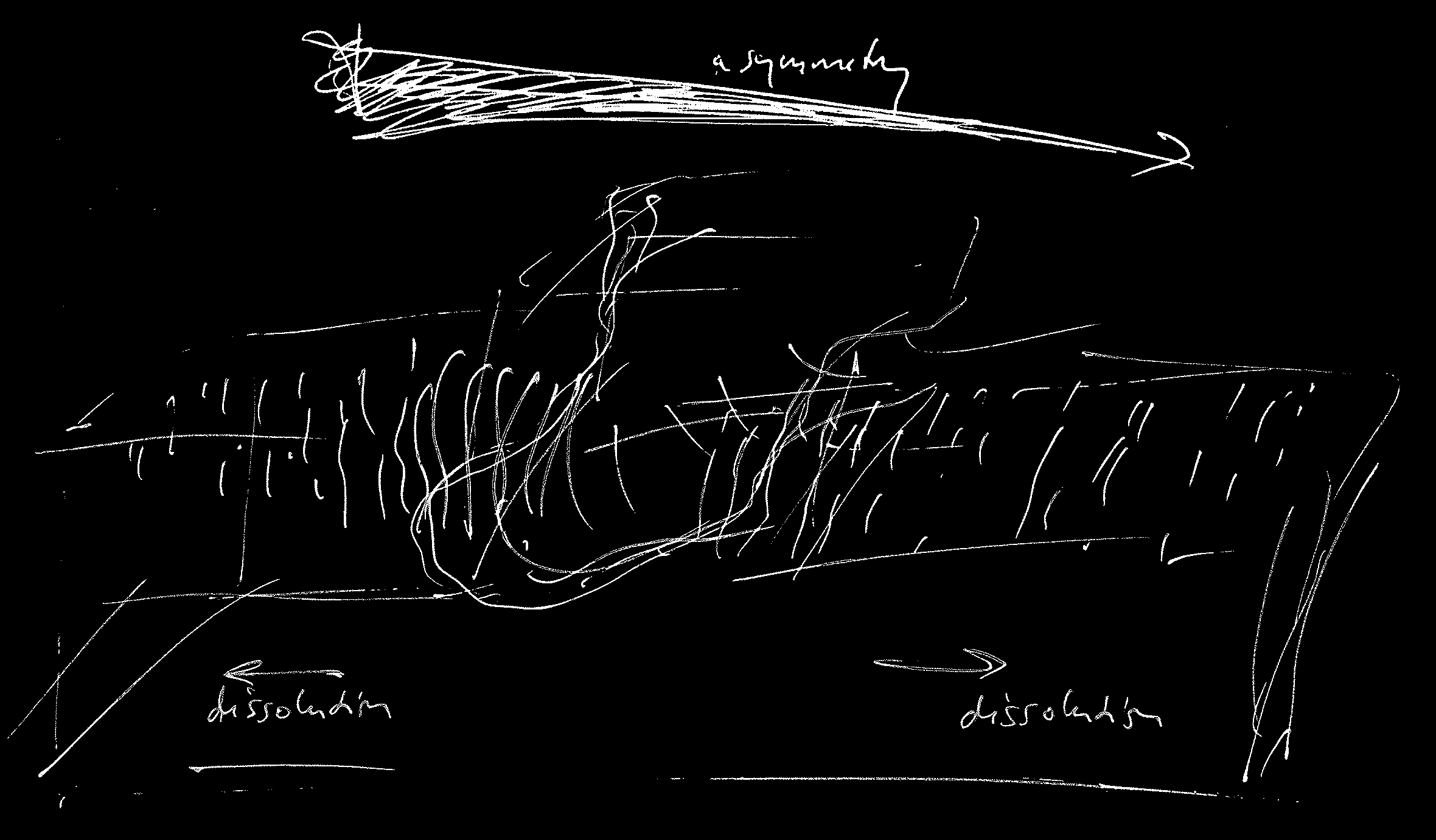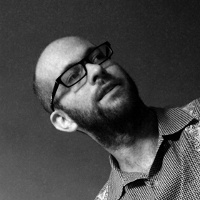On May 15, proposals for the visual design were presented by the students from Adriart. Three groups had been formed, each of which presented one approach.
The Cloud
The ‘cloud’ is a voluminous structure made from folded paper and suspended from the ceiling of the space. It is illuminated using neon tubes integrated in the interior of the object. The stiff paper forms several layers, resulting in varying degrees of luminosity. Numbers are printed on the paper. The group suggested to place the ‘cloud’ in the middle axis of the exhibition, parallel to the sight of someone entering from the main door.
The ‘cloud’ was equipped with two types of sensors. First, there are humidity sensors, and the visitors can blow into several holes in the cloud, creating a slowly saturating signal in the individual sensor. Second, the cloud can be cautiously moved itself which is picked up by an accelerometer (?).
The main problem with the ‘cloud’ is its pictorial quality. There is a conventional signification of what a cloud “looks like”, and it is aggravated by the fact that an “actual” cloud only appears to us as a static object with respect to the slow speed at which it develops its morphology. The group argued that they wanted precisely to make the cloud static to contrast with the motion in the sound composition, but I think it does not really address the conflict of a pictorial representation of a cloud versus the substance of a cloud. A cloud essentially is a dynamic process, and it is opaque but permeable at the same time. In this respect, I think the illumination from the inside with the varying degrees of opacity works well. To resolve the pictorial problem, a solution could be to move the concepts towards an abstract notion of cloud, cloudiness, etc.
The numbers printed on the cloud are not convincing, because again they become “illustrative”. On the other hand, instead of blank paper, one could imagine a metric texture on the paper which would support the change in density as the paper is folded.
The blowing sensors are playful, yet I imagine that they can be well utilised in the composition. They provide clearly delineated interaction elements on the one hand, but do not suffer from the stupor of using ‘buttons’, ‘switches’ etc. The motion sensor is more problematic, especially when considering that the object will be much larger in the actual exhibition space. There is essentially only one overall motion, no matter from what angle one approaches the cloud. If one was to stick to the motion sensor, I think the object must be disintegrated into coupled parts, so that several signals can be picked up.
The Threads
The ‘threads’ installation also uses suspension from the ceiling, this time using a net from which threads are hanging down in individual lengths, forming an abstract topology. Individual small paper squares are stringed up on the threads to produce a certain density of the space. In a way this proposal is not incompatible with the cloud as a concept, because again a permeable semi-opaque organic space is formed. The sensor question remains largely unanswered in my opinion. The group integrated two accelerometers, suspended as indivdual boxes among the threads. A connection between the visual installation and the sensors is missing, the sensors appear bulky and moreover are probably in danger of getting damaged easily. Richard and Visda hinted at the possibility of using different types of sensors which could be integrated with the threads themselves. The principal idea of activating the space by the traversal of the audience is nice, but it remains to be seen how this is technically implemented.
The Personal Space
The third proposal created visually demarked ‘rooms’ or sub spaces corresponding to rooms in a home, such as bath room, living room, … Within each sub-space phyiscal objects represented these rooms. The bathroom had a shower curtain equipped with bending sensors; the living room had a sofa with a number of pressure sensors and a little table with a lamp; the kitchen had a sink and a fridge with a sensor attached to the door. Each space had scent generators (e.g. when switching on the lamp, pressing the button of a hair dryer, …).
Although I liked the proposal, it has the biggest problems in terms of converging with the idea of climate-based sound installation that aims at a certain level of abstraction, technological rigour and the elements of experimentation or laboratory. The sensors as presented act mostly as object-based triggers, and it is difficult to imagine how to “navigate” the space.
Integrating
An element which I am missing is the engagement with the idea of ‘laboratory’. Perhaps it can be found in individual aspects of the proposals, such as the metal sink if stripped from the context of a ‘living room’, or the metric rigour of the grid in which the paper strips are suspended. I think one thought process must be to synthesise these timid elements into one overall structure. Also, none of the proposals have conciously included the positioning of the speakers, although they are pervasive elements of a dedicated shape (small cubicles). It is false to understand the speakers as afterthoughts in the visual approach, but the speakers and sensors should be the constraints from which the space is developed.
If we think of atmosphere as a conditioning of a space, my thought is that we should avoid dividing the space too much into parcels. The space itself is defined by the large amount of full height glass windows as well as the protusion in the middle. This can result in a symmetric structure which underlines the protusion, but one could equally imagine a “gradient” spanning the width of the space and giving it an asymmetry.
An idea that could be developed is the fusion of the ‘cloud’ and the ‘threads’ into a contiguous structure. Perhaps the cloud is “cut” by the outer wall of the protusion, and then disintegrates into the topology of suspended threads as it moves into the space.
What happens with the speakers? In the more solid cloud state, they could be integrated into the paper structure, but will introduce the problem of being completely opaque. In the airy thread-like state, one can hardly imagine them to hang next to the threads, but would probably place them either on the floor or ceiling level.
From the living room installation, the pressure pads are an interesting sensor, although using a lot of them on a small space, as was the case with the sofa, probably does not make sense, unless we want people to perform dance moves with their arses. I think these mats are very nice as floor boards that could be laid out liberally to cover a larger area of the space. On the other hand, one would have to ensure that the audience actually steps on and not over them?

Sound
It will be nice to create a continuum from the rather amorphous gray, pink and Brownian noise that was tentatively used in the cloud proposal towards more concrete textures based on recorded sounds which could be granularised etc. Another specific sound I am planning to work with is speech (probably synthetic). In one of the sounds used in the threads proposal, I accidentally forgot to cut out a moment where I was commenting on the recording. The sudden appearance of a voice was very interesting. It also goes well with my previous work in which sound material is systematically categorised so that sequences and combinations can be synthesised from a corpus. In the recent improvisation concerts I did this month, I could also observe how I focus more and more on evolving textures of synthetic sounds at the expense of rarely using field recordings. I think that the combination of homogeneous-but-complex abstract and synthetic sounds (which also can be easily parametrised) and a contrasting element such as voice will be a successful approach. It will be reduced, coinciding with the visual strictness and minimalism, opening enough space for the other two elements—interaction and sonification/parametrisation.
Another aspect that could play a prominent role is the concept of “markers”; to delineate (inter-)actions, the beginning and ending of gestures, the grid and resolution of data, the dimensions of the data, the metaphor of recording, sampling, sensing and counting, comparing.
